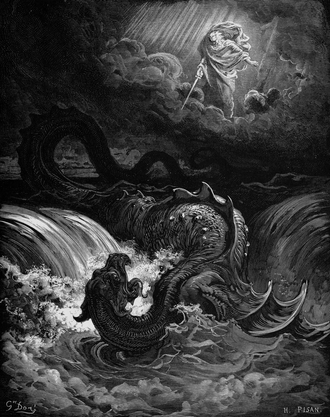Dragon
Mythical creature in various cultures
A dragon is a large, serpentine legendary creature that appears in the folklore of many cultures worldwide. Beliefs about dragons vary drastically by region, but dragons in western cultures since the High Middle Ages have often been depicted as winged, horned, and capable of breathing fire. Dragons in eastern cultures are usually depicted as wingless, four-legged, serpentine creatures with above-average intelligence.
Etymology
The English word "dragon" derives from the Greek word "drakōn," which means "serpent" or "giant sea fish." The Latin word "draco" also means "serpent" and is the source of the English word "draconian," meaning "harsh" or "severe."
Mythology and Folklore
Western Dragons
In Western mythology, dragons are often portrayed as evil creatures that hoard treasure and are slain by heroes. The image of the dragon as a fire-breathing, winged beast is a common motif in European folklore.
Medieval Europe
In medieval Europe, dragons were often depicted as large, fire-breathing, scaly lizards or serpents with wings, claws, and a barbed tail. They were often associated with evil and chaos. The dragon in the epic poem Beowulf is a prime example of this depiction.
Heraldry
Dragons were also used in heraldry, where they symbolized power, strength, and the ability to overcome adversity. The Welsh Dragon is a notable example, appearing on the national flag of Wales.
Eastern Dragons
In contrast, Eastern dragons are often seen as benevolent creatures associated with water, rainfall, and agriculture. They are revered as symbols of power, strength, and good fortune.
Chinese Dragons
Chinese dragons are legendary creatures in Chinese mythology and folklore. They are traditionally depicted as long, scaled, serpentine creatures with four legs. Unlike their Western counterparts, Chinese dragons are benevolent and associated with auspicious powers, particularly control over water, rainfall, typhoons, and floods.
Japanese Dragons
Japanese dragons are similar to Chinese dragons but are often depicted as more serpentine and less winged. They are also associated with water and are considered to be water deities.
Dragons in Religion and Myth
Mesopotamian Mythology
In ancient Mesopotamian mythology, dragons were often depicted as chaos monsters. The Sirrush is a famous dragon-like creature from the Ishtar Gate of Babylon.
Biblical References
The Bible contains several references to dragons, often symbolizing chaos and evil. The Leviathan is a sea monster mentioned in the Old Testament, often interpreted as a dragon.
Egyptian Mythology
In Egyptian mythology, the serpent Apep is a dragon-like creature that embodies chaos and is the enemy of the sun god Ra.
Cultural Depictions
Literature
Dragons have been a popular subject in literature, from ancient epics to modern fantasy novels. They often serve as formidable adversaries or wise mentors.
Art and Architecture
Dragons are a common motif in art and architecture, symbolizing power and protection. They are often depicted in sculptures, paintings, and carvings.
Related Pages
Transform your life with W8MD's budget GLP-1 injections from $125.
W8MD offers a medical weight loss program to lose weight in Philadelphia. Our physician-supervised medical weight loss provides:
- Most insurances accepted or discounted self-pay rates. We will obtain insurance prior authorizations if needed.
- Generic GLP1 weight loss injections from $125 for the starting dose.
- Also offer prescription weight loss medications including Phentermine, Qsymia, Diethylpropion, Contrave etc.
NYC weight loss doctor appointments
Start your NYC weight loss journey today at our NYC medical weight loss and Philadelphia medical weight loss clinics.
- Call 718-946-5500 to lose weight in NYC or for medical weight loss in Philadelphia 215-676-2334.
- Tags:NYC medical weight loss, Philadelphia lose weight Zepbound NYC, Budget GLP1 weight loss injections, Wegovy Philadelphia, Wegovy NYC, Philadelphia medical weight loss, Brookly weight loss and Wegovy NYC
|
WikiMD's Wellness Encyclopedia |
| Let Food Be Thy Medicine Medicine Thy Food - Hippocrates |
Medical Disclaimer: WikiMD is not a substitute for professional medical advice. The information on WikiMD is provided as an information resource only, may be incorrect, outdated or misleading, and is not to be used or relied on for any diagnostic or treatment purposes. Please consult your health care provider before making any healthcare decisions or for guidance about a specific medical condition. WikiMD expressly disclaims responsibility, and shall have no liability, for any damages, loss, injury, or liability whatsoever suffered as a result of your reliance on the information contained in this site. By visiting this site you agree to the foregoing terms and conditions, which may from time to time be changed or supplemented by WikiMD. If you do not agree to the foregoing terms and conditions, you should not enter or use this site. See full disclaimer.
Credits:Most images are courtesy of Wikimedia commons, and templates, categories Wikipedia, licensed under CC BY SA or similar.
Translate this page: - East Asian
中文,
日本,
한국어,
South Asian
हिन्दी,
தமிழ்,
తెలుగు,
Urdu,
ಕನ್ನಡ,
Southeast Asian
Indonesian,
Vietnamese,
Thai,
မြန်မာဘာသာ,
বাংলা
European
español,
Deutsch,
français,
Greek,
português do Brasil,
polski,
română,
русский,
Nederlands,
norsk,
svenska,
suomi,
Italian
Middle Eastern & African
عربى,
Turkish,
Persian,
Hebrew,
Afrikaans,
isiZulu,
Kiswahili,
Other
Bulgarian,
Hungarian,
Czech,
Swedish,
മലയാളം,
मराठी,
ਪੰਜਾਬੀ,
ગુજરાતી,
Portuguese,
Ukrainian
Contributors: Prab R. Tumpati, MD







